#Rumex acetosella
Explore tagged Tumblr posts
Text


5/24/24
#plant#flowering plant#Rumex acetosella#sheep's sorrel#eucidots#Caryophyllales#Polygonaceae#edible plant
0 notes
Photo
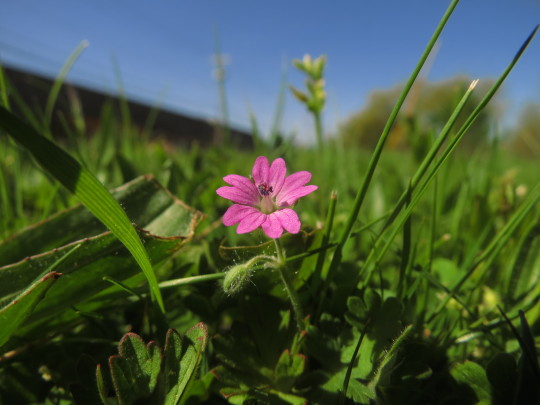
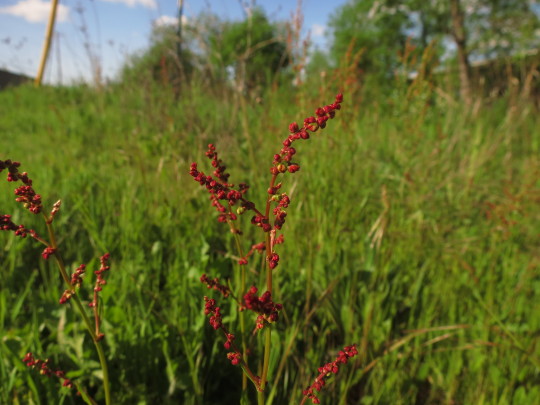

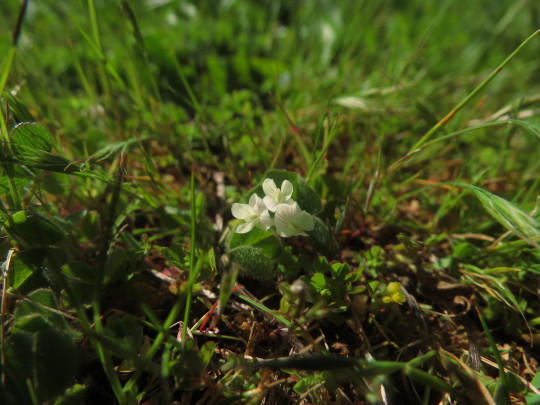
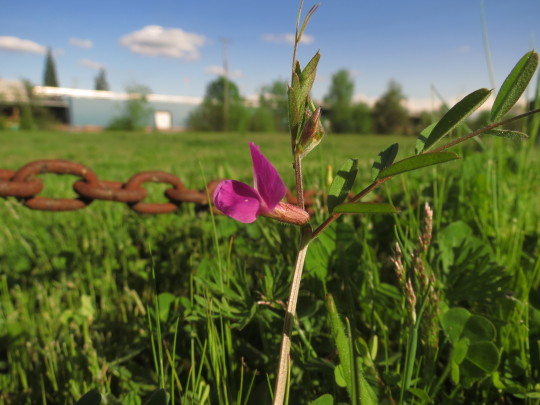
SE Milport Road and McBrod Ave, Milwaukie, Oregon
From top to bottom: geranium (Geranium sp.), sheep sorrel (Rumex acetosella), changing forget-me-not (Myosotis discolor), subterranean clover (Trifolium subterraneum), common vetch (Vicia sativa)
#johnson creek#milwaukie oregon#geranium#rumex acetosella#myosotis discolor#trifolium subterraneum#vicia sativa#weeds
1 note
·
View note
Text

Not 100% on the ID but I thiiink it might be Raununculus acris, the common buttercup, and Rumex acetosella, red sorrel. No idea what the purple ones might be.
#Dronningsstien#H.M. Dronning Sonjas Panoramatur#Norge#Norway#Hordaland#Hardanger#Vestlandet#Hardangervidda#hiking#hiking trail#nature#wilderness#August#2022-08-14#flora#wildflowers#buttercup#sorrel#Raununculus acris#Rumex acetosella#maybe#photography#digital photography#DSLR#Canon 6D#photographers on Tumblr
1 note
·
View note
Text

Väike oblikas (Rumex acetosella)
Saksa keeles Kleiner Sauerampfer, inglise keeles red sorrel, field sorrel või sour weed.
Mitmeaastaline õistaim oblikate perekonnas, tatraliste sugukonnas ja nelgilaadsete seltsis.
Pärit Euroopast ja Aasiast, leviala on Kreetalt kuni Norra põhjatipuni ja Briti saartelt kuni Siberi idatipuni ja Jaapani. Hiljem viidi ka Põhja-ja Lõuna-Ameerikasse, ning Austraaliasse, Lõuna-, Kesk- ja Kagu-Aasiasse. Tal on vaja kergeid happelisi ja liivaseid, vähese viljakusega. Leidub nõmmedel, happelistel põldudel ja rohumaadel või karjamaal, aga ka aias. On üks esimesi taime, mis näiteks pärast mullaharimist või muid inimtegusi hakkab asustama jäätmaad.
Ühest taimest võivad tulla 1000-2500 seemneid, mis suudavad talvituda ja siis idaneda kiiresti, kuni 4 cm sügavuseni, kuigi 1 cm või vähem on nende jaoks ideaalne. Idanemisvõime säilib mullas kuni 10 aastat, ja ka loomade seedekanalites. Paljuneb ka risoomidega, võrsetest kasvavad kergesti uued taimed. Kasvab 10-40 cm kõrguseni.
Väikest oblikat saab nagu hapuoblikad salatites, suppides, kastmetes ja vormitoitudes kasutada. Sobib ka maitsetaimena, meenutades sidrunit ja rabarberit. Suurtes kogudes võib aga inimestel neeru kahjustada ja ka kasuloomadel terviseprobleemi põhjustada.
Pilt: Henripekka Kallio, CC BY SA 2.5, Wikimedia Commons
#taim#rohttaim#katteseemnetaim#õietaim#kaheiduleheline#nelgilaadne#tatraline#oblikad#umbrohi#söögitaim#maitsetaim#mitmeaastaline#vikipeedia pilt#3. õppehoog
2 notes
·
View notes
Text
#2677 - Prodontria lewisii - Cromwell Flightless Chafer

This, apparently, is the only nature reserve in the world set up to protect an insect. This is the only place in the world where its found. There USED to be a second population, and then they decided to add another 9 holes to the local golf course.



The beetle has a very limited habitat - inland shallow sand dunes deposited at the end of the last Ice Age - and it has to be clear of woody weeds like pines and gorse. Most of that terrain was destroyed by the construction of the Cylde Dam and the flooding of Lake Dunstan. So there's only these 81 hectares left.
The larvae live underground, feeding on plant roots. Adults emerge on warm humid nights to mate, and feed on lichens and plants including cushion plant (Raoulia australis) speedwell (Veronica arvensis), and sheep's sorrel (Rumex acetosella).
Introduced predators include hedgehogs, little owls, Australian redbacks, and possibly European earwigs.
Cromwell, Aotearoa New Zealand
#Prodontria#Scarabaeidae#endangered species#new zealand beetle#cromwell#cromwell nz#cromwell new zealand#cromwell flightless chafer#cromwell flightless beetle#cromwell chafer beetle
1 note
·
View note
Text
sheep sorrel
Sheep sorrel, scientifically known as Rumex acetosella, is a perennial herb that is commonly used as an ingredient in the popular herbal tea blend called Essiac tea. Here is some information about sheep sorrel and its benefits: Description: Sheep sorrel has slender, pointed leaves that resemble the shape of a spear or arrowhead. It is a low-growing plant that can reach a height of about 30…
View On WordPress
0 notes
Text
0 notes
Note
top 5 plants you might see on a walk/hike? And top 5 songs to sing along with?
hii, thanks for the ask!
plants:
polygala nana, aka candyroot. its roots smell and taste a bit like licorice and its flowers are really beautiful.
bay laurel. its leaves are good for soup.
the illustrious sarracenia leucophylla! the carnivorous pitcher plant. bit of a bog to get to them but it's worth it.
various types of ground and tree lichen! not technically plants so i won't count it but still a very integral part of a nature walk here.
huckleberry bushes which are basically wild blueberries.
rumex acetosella, aka red sorrel or sheep's sorrel. it came here from europe and is invasive but you can eat the leaves and chew on the stem and bc it's invasive, you very much should! it tastes good, kind of a sweet, sour flavor. i am single-handedly trying to eat them to extinction.
songs:
if i had a heart - fever ray
it will come back - hozier (and like 20 other hozier songs tbh)
bloodflood - alt-j
the only thing i know - gotye
why won't you make up your mind (erol alkan rework) - tame impala
1 note
·
View note
Text
Plant Profile: Sheep Sorrel
Plant Profile: Sheep Sorrel
A Rich Source of Vitamin C, E, Beta-Carotene, and Other Carotenoids
Sheep sorrel (Rumex acetosella) is a herb that many Americans consider to be just a common weed, particularly in areas where blueberries grow. However, its medicinal uses have been known for quite some time. In fact, it has recently received extra attention for its use in a common cancer tea. Historically, sheep sorrel has been…
View On WordPress
1 note
·
View note
Text







Le rumex acetosella - petite oseille
La petite oseille, ou vinette en français acadien et en poitevin, est une plante herbacée de la famille des Polygonacées. Elle pousse dans les endroits rocailleux, en terrain acide.
Nom scientifique : Rumex acetosella
Classification supérieure : Oseille
Rang : Espèce
0 notes
Text
La Coltivazione di Acetosa
Rumex acetosa, Polygonaceae, acetosa maggiore, erba brusca, saleggiola Diverse specie di Rumex sono diffuse nelle nostre regioni, dalla pianura alla montagna. Gli agricoltori ben conoscono Rumex crispus o Rumex obtusifolius. Anche la vera acetosa (Rumex acetosa) cresce spontanea nei prati e può divenire infestante, ma sovente viene coltivata negli Orti come ortaggio. L’acetosa è molto rustica e…

View On WordPress
0 notes
Text
Dead Wood Isn't Dead Weight in Habitat Restoration
I've been slowly rewilding my yard; almost every plant growing in it when I moved in was non-native, from purple foxglove (Digitalis purpurea) to sheep sorrel (Rumex acetosella) to at least four species of non-native grasses. The natives were sparse, mostly limited to beach strawberries (Fragaria chiloensis), trailing blackberry (Rubus ursinus), and field horsetail (Equisetum arvense), along with a few native shrubs like salmonberry (Rubus spectabilis) and twinberry honeysuckle (Lonicera involucrata).
A lot of what I've been doing is removing non-native species while introducing native ones. It's been an uphill struggle since the non-natives are largely species that have evolved to quickly colonize disturbed land and out-compete most of the natives, which has meant a LOT of weeding. In some cases when I've had to open up entire areas of the yard that will have heavy foot traffic, I've had to sow various clovers as a quick solution to keep the other non-natives from crowding their way in. Clover, at least, is easier to remove, and once I have a chance to kill it it will release the nitrogen it has collected into the soil, making it a better spot for whatever I plant there next.
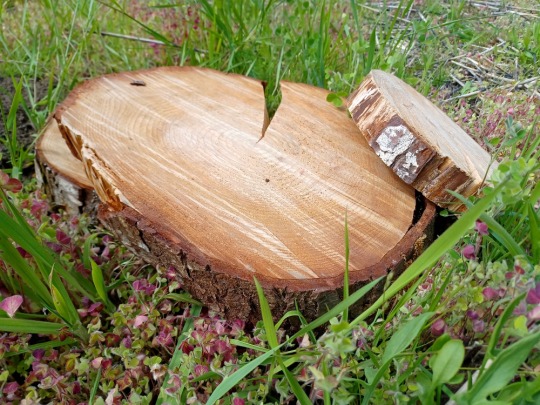
This morning before I started work I decided to get just a little more gardening in. I had these three log slices I was given a while back; the largest is over a foot in diameter. I decided to use them to create a small woody debris pile in one part of the yard that was rather sparse on such things. It's nothing too fancy; they're simply leaning on each other to create a little space underneath.
But these are important additions to this habitat in progress. Lots of living beings rely on dead wood for food or shelter--or both. While these wood slices look pristine now, it's likely that in the next few years they'll collect an array of inhabitants, from lichens and moss to insects and bacteria. Some of these will simply take up residence in the shelter I've created; others will do their part as decomposers and break down the cellulose and lignin in the wood. Eventually, if left in place, the slices will eventually return to the soil, adding to the nutrient load being passed around from being to being in this ecosystem.
Most often when woody debris is mentioned in habitat restoration, the focus is on large example like entire snags, nurse stumps, and nurse logs, or on dead trees piled up in rivers and streams. These are, of course, important examples thereof. However, many people don't have the space for an entire dead tree in their yard. In that case, smaller installations are perfectly reasonable and will still create habitat for your local wildlife like insects and other arthropods, snakes, toads, etc.

I also took the opportunity to take a quick peek at a stack of red alder (Alnus rubra) logs I had set up a couple of years ago. They'd already brought their own patches of moss, but the wet weather and resident decomposers have been doing their work, and the bark is beginning to slough off of some of them.

The previous owner of this property did some landscaping with dead wood; this is probably the largest, an old log about five feet long that I think looks a bit like an alligator's head. As you can see, it's pretty weathered at this point; the old knot has rotted out and the remaining wood has numerous cracks and splits, and the bark has long since decayed.
I'm going to keep adding small wood piles around the yard as I'm able to make space for them. They do need to be worked around when I'm attending to live plants, and can be an obstacle to mowers and other tools. I want to not have to disturb these little habitats once they're established, so I'll be adding them in deliberately. This sort of planning is important if you're going to be creating woody debris piles in your yard as well, so that your local wildlife are free to set up their homes without worrying about sudden eviction. If you're in an area with venomous snakes, or if you're concerned about termites or carpenter ants using a wood pile to hopscotch over to the wood in your home, you may want to make sure you create habitat further away from the house and other buildings. Finally, make sure that no one uses these piles as jungle gyms; the animals living inside them can be easily crushed if the wood is shifted around or compressed.
Did you enjoy this post? Consider taking one of my online foraging and natural history classes, checking out my other articles, or picking up a paperback or ebook I’ve written! You can even buy me a coffee here!
#habitat restoration#ecology#nature#wildlife#animals#plants#fungi#science#scicomm#gardening#garden#outdoors#environment#environmentalism#conservation#long post#rewilding
296 notes
·
View notes
Photo

Szczaw polny (Rumex acetosella L.) / Red Sorrel
0 notes
Text
One of the finest bases for a salad is young heart-shaped leaves from the lime tree, the very best being from the small-leaved lime (Tilia cordata), which are hairless. These should be shiny and lime green in colour. They taste just like lettuce – surprisingly so – but I think they hold salad dressing better and don’t wilt so fast. They are exceptionally good in sandwiches.
I also like the very youngest leaves of hawthorn ( Crataegus monogyna); again, they need to be a vibrant, new green and just a few centimetres long. The leaves are alternate, as opposed to opposite, so borne along the stem in an alternate spiral, with five to seven lobes and teeth on the tips. Hawthorn leaves are said to protect the heart both emotionally and physically, and are known to be good for circulation. They taste fresh and grassy green and their pretty serrated edges make them attractive for salads.
I cannot get enough of dandelions (Taraxacum officinalis) at this time of year. Every part is edible and packed full of good stuff: they are rich in potassium, for instance. They are bitter, like an endive, but sometimes more so, thus you need to go for the very youngest inner leaves, again lime-green, indicating new growth. If the bitterness is too much, soak them in salted water for 10 minutes or so. In salads, I am also mad about the flower stems, which taste a bit like Italian chicory (puntarelle) and can be treated exactly the same way. You only want the new stems of flower buds or flowers; by the time the plant is setting seed the stem will be full of chewy fibres. I chop the stems diagonally into segments, salt them well and then dress them in oil and little else. They are very good with chopped boiled eggs and a little finely diced red onion.
Chickweed (Stellaria media) is another excellent base, with a flavour not too dissimilar to that of corn salad. It may well be in flower now, but if it is growing somewhere damp enough, will still be tender. It is low-growing and mat-forming, with delicate little egg-shaped leaves and tiny white flowers.
The wild garlic (Allium ursinum) season is almost over, but in cooler spots you may find unripe seed to pick. These will appear on the ends of the seedheads and are ball-shaped, in clusters of three. They should be bright green in colour, rather than yellow. They give an intensely sweet garlic burst and are particularly good turned into salt (mix equal parts coarse sea salt and seeds), which will preserve into winter. This is very good in salad dressings.
Lemon balm (Melissa officinalis), fennel (Foeniculum vulgare) and perennial wall rocket (Diplotaxis tenuifolia) are garden escapees that are often found in abundance in cities and towns along paths and walls and are excellent for bulking out a salad.
Sheep’s sorrel (Rumex acetosella) is another good one, though you want it growing somewhere damp so that it is succulent. In dry spots, it gets very tough. It has oblong, arrow-shaped leaves and tall spikes of pink flowers. If it has flowered (which is likely right now) and gone to seed, steal these if they are still bright pink and fleshy. Scattered through a salad, they give a pleasing burst of lemon.
The unopened flowers of narrow-leaved or ribwort plantain (Plantago lanceolata) can be briefly steamed until tender, allowed to cool and dressed with a vinaigrette and tossed into a mixed salad or treated a little like asparagus, although they taste surprisingly like mushrooms. The leaves are long, narrowly oval with veins running parallel from the base to the top. The flower spikes are square and the unopened flowers are pine cone-shaped.
Likewise, the unopened flowers of oxeye daisy (Leucanthemum vulgare), which looks like an oversized lawn daisy and grows to 60cm high, can be briefly steamed and marinated, or pickled like capers. The white petals are lovely scattered in for some colour. The leaves are also edible, although they are quite bitter and perfumed by the time the plant flowers. If you can find them before then, they are much more desirable.
A better option are the leaves of the common or lawn daisy (Bellis perennis), which can be used raw, where they have an interesting fleshy texture, or cooked, which is my preferred method. The leaves are paddle-shaped and slightly hairy. Once cooked, they soak up dressing in a very pleasing manner. The flowers can be eaten too – they don’t taste of much, but look pretty.
Finally, there are excellent vinegars to be made from creamy white umbels of common elder (Sambucus nigra), the long, tubular yellow flowers of common honeysuckle (Lonicera periclymenum) and palest pink petals of dog rose (Rosa canina). All can be found in hedgerows right now. The adventurous can make these vinegars from scratch, by fermenting the flowers in sugar and water, but that takes time, so for a quicker solution use good-quality white wine vinegar or raw cider vinegar and infuse just the flowers (never the stems) for several days for a deliciously perfumed dressing.
Some of these are may be fairly region specific, but several also happen to be invasive in a lot of places, making them great foraging options. The link contains some helpful dos and don'ts, and suggestions for further reading, so if you are interested but new to foraging, I recommend clicking through.
#foraging#food#salads#food security#plants#personally I can't stand the taste if dandelions but there are so many hawthorns here and now I'm keen to try that
9 notes
·
View notes
Photo






The fruit of a Rumex sp. (not sure if it is Rumex acetosella) in NE Turkey.
117 notes
·
View notes
Text
facebook deleted my note so i’ll keep one here
---things that cure, treat, thwart or slow cancer. effective or not, in vitro or not. with varying degrees of toxicity and processing-- thangs big pharma don’t want you to know.
714X(trimethylbicyclonitramineoheptane chlorid) Abelmoschus esculentus (Okra) Abrus Acidianus virus Actaea racemosa (or black cohosh) Acupuncture ADOPTIVE cell transfer AHCC Arctostaphylos uva-ursi alkline diet Allium cepa (extract) Allium nigrum (Black Garlic) ? Allium sativum? (Maillard reaction) Almonds alterd polio/polio vaccine Amaryllidaceae (spider lillies) Amblyomma cajennense( saliva compounds from Cayanne tick) Amomum subulatum (black cardamom) Elettaria (green) Andrographis paniculata anethum graveolens(dill) Annona muricata (soursoup) all other Annona genus/ Annonaceae family anti fungals? Anti-cancer psychotherapy antibiotics Antineoplaston therapy ANTI NEO PLASTONS Apitherapy Applied kinesiology Apricots (kernels/seeds) ARGININE (1-ARGININE arsnic trioxcide Artemisia annua ( wormwood/sweet annie/sweet sagewort/annual mugwort or annual wormwood) ARTEMISININ AVEMAR Bach flower remedies Bhasmas minerals, metals and jems barefoot walks in the connifer forest battery acid (*only listed in case it -does- destroy tumors in a petridish) Bean sprouts bee propolis beer(hops?) Berlinia grandiflora BETA GLUCANS, 1, 3, 6 biblical diet bioactive polysaccharides BIOMAGNETISM black cumin (Bunium bulbocastanum? Nigella sativa ?) Black salve Blackberries bleach (possibly, in vitro only)https://www.cancertutor.com/chlorine_dioxide/ Blood (Turtle, Alligator, ) Blueberries boswellic acids (Frankensence) BOVINE CARTILAGE Breuss diet Buckwheat Budwig diet Caesium chloride Cancell Cancer guided imagery canna Cannibis oil Capsicum annuum (Guinea spice, cow-horn pepper, aleva, bird pepper) Carctol carotene Carum carvi (caraway) Cashews Catharanthus roseus (rosy periwinkle/teresita) Cavia porcellus (guniea pig ,with ritual) chelaton therapy Chelidonium majus. Chlorella chlorophyll chloroquine Citrus limon Osbeck (lemon) Citrullus lanatus (watermellon) Clark's "Cure for All Cancers" coffie enemas Coix lacryma-jobi (jacob's tear/job's tear) Coley's Vaccine therapy Colloidal silver colorpuncture CONJUGATED LINOLEIC ACID OR CLA Contreras Therapy Convallaria majalis Convolvulus (bindweed) CoQ10, Coral calcium Coriandrum sativum (corriander) Craniosacral therapy Crocus sativus (safforn) Croton lechleri Cruciferous vegetables Cucumis sativus (cucumber) cucurbitacins Cuminum cyminum(cumin) cupping Curcuma longa (tumeric) Cytokine therapy D-GLUCARATED daffodill (Amaryllidaceae?) dasatinib dance detox footbath, with intravenous vitamin therapy, cranial electrotherapy stimulation, combination infrared waves plus oxygen, acupuncture, colon hydrotherapy, Di Bella Therapy DI-INDOLE METHANE (from cabbage) Dieffencachia maculata,(dumb cane) Dionaea Muscipula (Venus flytrap Carnavoria brand extract, anti tumor?) disulfiram/Antabuse DMSO dry fasting ear candeling Elderberries Electro Physiological Feedback Xrroid Electrohomeopathy elephant P53 and TP53 Elettaria|Amomum|Zingiberaceae (Cardamom) Ellagic acid emu oil EPICAN FORTE® Erecial dysfunction drugs (for after tumor removal surgery) Essiac tea = ( burdock (Arctium lappa), sheep sorrel (Rumex acetosella), slippery elm bark (Ulmus rubra), and Indian rhubarb (Rheum officinale) or turkey rhubarb (Rheum palmatum).[3] Some formulations may also contain watercress, blessed thistle, red clover, and kelp) Eugenia caryophyllata (clove) Euphorbia tirucalli (firestick) Eutrema japonicum/Wasabia japonica (wasabi) Fallopia japonica/Reynoutria japonica (Japanese Knotweed) FAR INFRARED THERAPY fasting Fava beans ferro fluid FLAVONOIDS Foeniculum vulgare (fennel) Fontainea picrosperma (Blushwood berry) (Hylandia dockrillii ..?) Fragaria? (strawberries /) FUCOIDAN GcMaf and transforming-growth-factor-beta GEIPE THERAPY Gelsemium elegans (heartbreak grass) Germanium German New Medicine (GNM) ginger tea Gingerol Glyconutrients gold Goldenseal (or Hydrastis canadensis) Gonzalez protocol Gotu kola Guiera senegalensis HANSI THERAPY heat HIV Hordeum vulgare (barley) Hoxsey therapy HULDA CLARK'S THERAPIES human breast milk Hydrazine sulfate hydrogen-peroxide Hyperbaric oxygen therapy hypnosis HYPOTHERMIA THERAPY IMMUNOCAL® Indole-3-carbinol (found in broccoli) Influensa Vaccine (for after tumor removal surgery) Inonotus obliquus(Chaga) Insulin potentiation therapy IP6® IPT (INSULIN POTENTIATED THERAPY) Issels treatment juicing Junk DNA k3 Kalanchoe Kangen Water Kelley treatment KEYTRUDA kinase inhibitors Krebiozen Krebiozen LACTOFERRIN
laetrile/laevo-mandelonitrile-beta-glucuronoside,/amygdalin/Vitamin b 17/Nitriloside lapacho tea laughing Lauraceae (cinnamon) Larotrectinib Ligustrum lucidum (Glossy privet) Linalool Lima beans limonene Lipoic acid Live blood analysis LifeOne Protocol Livingston-Wheeler Therapy Lorraine Day's 10-step program low sugar diet lye lymphatic drainage LYMPHOTONIC PF2 Macadamia nuts Macrobiotic diet magnets meditation Metabolic therapies MGN3, Millet Miracle Mineral Supplement MG-LZ8 (Ganoderma lucidum ) MODIFIED CITRUS PECTIN Moerman Therapy Momordica charantia (bitter mellon) Morinda citrifolia (noni) Moringa oleifer (moringa/ drumstick tree/horseradish tree/ ben oil tree/or benzoil tree Moxibustion MYCOSOFT GOLD® naked mole rats don't get cancer N-TENSE® Neuro-linguistic programming Nieper therapy Ocimum sanctum/Ocimum tenuiflorum (holy basil) oleander OMEGA 3 FATTY ACIDS Oncolyn® Oncotox® Orgone Origanum vulgare (oragono) Orthomolecular medicine oxygen therapy P53 genes P80 Natural Essence Panchagavya pangolin Pau-d-arco Peperine Peristrophe bicalyculata Persea americana (avacado, the pit part) pH Balancing Phyllomedusa sauvagii phytoestrogen phytolacca decandra (American pokeweed) Picea(spruce genus)Alpha- & Beta-Pinene Pimenta dioica.(allspice) platinum Plumbagin (see carnavoria?) Plumbago zeylanica (ceylon leadwart) Polarity therapy Poly-MVA Polybia paulista venonm (a wasp) Poria cocos/Wolfiporia extensa (hoelen/ poria/tuckahoe/ China root/fu ling/matsuhodo Portulaca Oleracea (Purslane) positive mental outlook prayer(??) proanthocyanidins Proteolytic enzymes Protomorphogens Prunus avium and P.cerasus (cherry)Prunus africana Psychic surgery purple rice Qigong quark cheese and flax (http://www.getholistichealth.com/41061/the-industry-suppressed-budwig-protocol-or-how-to-cure-cancer-with-cottage-cheese/) Quercetin radiation Radiosensitization raido frequencies Raspberries Rauvolfia serpentina (or snakeroot) reiki Resveratrol Revici's Guided Chemotherapy Rhinella marina venom (cane toad) rhinocerous horn ricin RIGVIR Rosmarinus officinalis(rosemary) Sanguinaria canadensis (bloodroot) sea cucumber (Holothuroidea?) sea silver seeds from other fruits like apples, cherries, peaches, prunes, plums, pears Selenium Serenoa repens (saw palmetto) shark cartilage Shiatsu Silybum marianum (milk thistle) smelling farts smoothie:https://pinklotus.com/wp-content/uploads/2017/11/DrFunksAntioxidantSmoothie.pdf sodium bicarbonate (bakingsoda) Sorghum sour honey Stellaria media (chickweed) Strawberries Strychnos nux-vomica(Strychnine tree) sun light swiftlet nests Taraxacum (dandilion genus) Taxus wallichiana (Himalayan yew) Thapsia garganica (deadly carrots) this salad http://realfarmacy.com/make-giant-cancer-killing-salad/ Thymus vulgaris (common thyme) Tigilanol_tiglate /ebc-43(from blushwood berry) TO-MOR-GONE Trametes versicolor/Coriolus versicolor/olyporus versicolor (turkey tail mushroom) Transfer Factor Plus Trifolium pratense (red clover) Tripterygium wilfordii(thunder god vine) urine , cow, dog (http://www.cowurine.com/cancer.html) Ultraviolet Blood Irradiation Uncaria guianensis, Uncaria tomentosa (or cat's claw) varicella vegan diet Venom Peptieds (various spider and pit viper species, arazonian bark scorpian) VG-1000 VIBE Machine vibrations Vinblastine Virginia Livingston Therapy Viscum album (misletoe) (Iscador) Vitacor vitamin c (ascorbic acid ? ) vitamin D waiting for your immune system (http://www.getholistichealth.com/41065/the-american-cancer-society-admitted-that-untreated-cancers-often-go-away-naturally/) Waxy monkey tree frog, skin compounds wheatgrass Whipple Procedure, Wigmore therapy Withania somnifera(Indian ginsing/ zapotin Zingiber officinale (ginger) Zoetron therapy
http://www.getholistichealth.com/40674/the-miracle-drink-that-kills-cancer-cells/
•Fava beans •Raspberries •Strawberries •Blackberries •Blueberries •Buckwheat
•Macadamia nuts •Bean sprouts All are the highest sources of absorbable vitamin B17.
https://cancerwontbeatme.com/2014/10/02/a-list-of-78-proven-therapies/#more-164 https://thetruthaboutcancer.com/medicinal-mushrooms-cancer/
https://www.npr.org/sections/health-shots/2017/07/12/536812206/living-drug-that-fights-cancer-by-harnessing-the-immune-system-clears-key-hurdle?utm_source=facebook.com&utm_medium=social&utm_campaign=npr&utm_term=nprnews&utm_content=20170712
2 notes
·
View notes